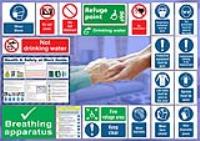 Add My Company
Add My Company
Sign In
How Labels and Signs Help Care Home Staff
16-03-2022

Care homes are naturally risk-prone due to the nature of having vulnerable residents. By complying with COSHH guidelines and making risks clear to their residents through labels and signage, employers and carers can make care homes a safer place to be.
Below, we discuss the main elements of care home safety, how to use nursing home signage and the role COSHH has in care homes.
What is COSHH?
COSHH (Control of Substances Hazardous to Health) is a set of regulations that protect workers from harmful substances that they may interact within the workplace. It is a criminal offence to breach COSHH regulations – something that good signage can help prevent.
Employers must complete a COSHH risk assessment and implement procedures to minimise all risks found, as well as supply health and safety training for all employees.
We have covered COSHH in a previous post: What are the COSHH Regulations?
There are two acronyms that fall specifically under COSHH in care homes:
REACH
REACH is the Registration, Evaluation, Authorisation and Restriction of Chemicals. It is an EU regulation that means that any substance must be registered with the European Chemical Agency if it weighs one tonne or more.
To do so, a Safety Data Sheet (SDS) must be completed and submitted by the supplier or the hazardous substance.
Britain’s role in REACH has changed since leaving the EU. However, broadly, the country’s commitment to REACH standards has remained the same, especially in sensitive places like care homes.
CLP
CLP stands for Classification, Labelling and Packaging. This requires that all supplies use the same images on packaging for hazardous products to remain recognisable in all environments. This is known as a Globally Harmonized System (GHS).
It’s particularly relevant to have clear and accurate health and safety signage in environments concerning vulnerable people. For example, you may need to consider more frequent placement or dementia friendly signage to achieve sufficient care home safety. Large, clear fonts and images that comply with CLP, as mentioned above, help with this.
Hazardous Substances in Care Homes
Clear nursing home signage and labels can make residents more aware of day-to-day risks such as slippery floors, steps, hot surfaces, or power cables.
It is, however, crucial to identify the hazardous substances in care homes which would require compliance with COSHH, and in this context they fall under three main categories. These may include, but are not limited to:
Cleaning Products
Irritants, including bleach-based cleaners or anything that releases fumes/vapours, such as oven cleaner
Disinfectants (which can be harmful if inhaled)
Sulphuric acid or other corrosive ingredients found in drain cleaning
Floor cleaning products, detergents, or other substances that can be irritating if in contact with eyes or skin
Maintenance
Water treatment chemicals
Wood/concrete dust in the air from ongoing work
Paints/solvents/glues can be harmful if not used in a well-ventilated area.
Resident Related
Medicines
Faeces and urine (could be found on soiled bed sheets and clothing)
Blood (if a resident has a fall or other accidental injury)
Keeping Care Homes Safe with Signage
PPE with accurate signage reduces exposure to hazards and keep care home residents safer, particularly in the presence of chemicals or irritants.
At Label Source, we supply a range of health and safety labels and signage including PPE signs that are easy to understand for both staff and residents in care homes. These all consist of a blue circle with a white pictogram above matching squares of white text on blue backgrounds.
For other news on health and safety, follow us on Twitter.
For more information on How Labels and Signs Help Care Home Staff talk to Label Source
Enquire Now
List your company on FindTheNeedle.

